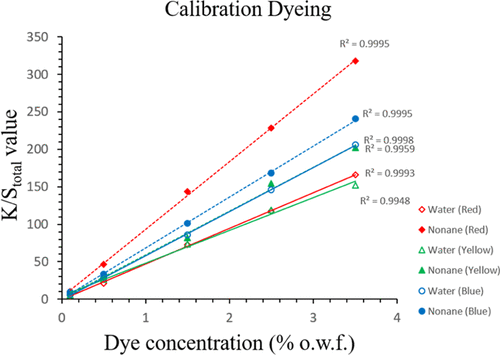Our official English website, www.x-mol.net, welcomes your feedback! (Note: you will need to create a separate account there.)
Dyeing Properties of Cotton with Reactive Dye in Nonane Nonaqueous Reverse Micelle System
ACS Omega ( IF 4.1 ) Pub Date : 2018-03-08 00:00:00 , DOI: 10.1021/acsomega.8b00032 Alan Yiu Lun Tang , Cheng Hao Lee , Yanming Wang , Chi Wai Kan
ACS Omega ( IF 4.1 ) Pub Date : 2018-03-08 00:00:00 , DOI: 10.1021/acsomega.8b00032 Alan Yiu Lun Tang , Cheng Hao Lee , Yanming Wang , Chi Wai Kan

|
In this study, we explored the dyeing behavior of cotton with reactive dyes in poly(ethylene glycol)-based reverse micelle system in nonaqueous alkane medium of nonane (C9H20). Calibration of dyeing databases for both conventional aqueous-based dyeing method and nonaqueous nonane reverse micellar dyeing method was initially established, along with simulated dyeing of standard samples with known concentrations. Several color difference formulae were used to conduct computer color matching (CCM), by matching the color between batch samples and the standard samples, for both dyeing methods. Excellent color matching results were achieved as both dyeing methods showed that the CCM-predicted concentrations were nearly the same as the known concentrations. It indicates that utilizing nonane as a solvent to facilitate reverse micellar dyeing of cotton can achieve good color matching when compared with that of the conventional aqueous-based dyeing system. Relative unlevelness indices were used to evaluate the evenness of the dyed samples. Good to excellent levelness results were obtained, comparable to that of the conventional aqueous-based dyeing system. Color fastness to laundering of nonane reverse micellar dyed samples was found to be good for industrial applications. In addition, during the reverse micellar dyeing process, only very low level of volatile organic compound content was detected and 98% nonane could be recovered simply by fractional distillation. The results in this study explored the practical usage of nonane nonaqueous reverse micellar approach on the dyeing of cotton with the use of reactive dyes.
中文翻译:

壬烷非水反胶束体系中活性染料对棉的染色性能
在这项研究中,我们探索了在壬烷(C 9 H 20)。最初建立了针对常规水基染色法和非水壬烷反胶束染色法的染色数据库的校准,以及对已知浓度的标准样品进行模拟染色的校准。对于这两种染色方法,通过匹配批次样品和标准样品之间的颜色,使用了几种色差公式进行计算机颜色匹配(CCM)。两种染色方法均显示CCM预测的浓度与已知浓度几乎相同,因此获得了出色的色彩匹配结果。这表明与传统的水基染色系统相比,利用壬烷作为溶剂促进棉的反胶束染色可以实现良好的配色。相对不流平指数用于评估染色样品的均匀度。与传统的水基染色系统相比,可获得良好至极好的流平性结果。发现壬烷反胶束染色样品的耐洗色牢度对于工业应用是良好的。另外,在反胶束染色过程中,仅检测到极低水平的挥发性有机化合物含量,并且可以通过分馏简单地回收98%的壬烷。本研究的结果探索了壬烷非水反胶束方法在活性染料染色棉上的实际应用。发现壬烷反胶束染色样品的耐洗色牢度对于工业应用是良好的。另外,在反胶束染色过程中,仅检测到极低水平的挥发性有机化合物含量,并且可以通过分馏简单地回收98%的壬烷。本研究的结果探索了壬烷非水反胶束方法在活性染料染色棉上的实际应用。发现壬烷反胶束染色样品的耐洗色牢度对于工业应用是良好的。另外,在反胶束染色过程中,仅检测到极低水平的挥发性有机化合物含量,并且可以通过分馏简单地回收98%的壬烷。本研究的结果探索了壬烷非水反胶束方法在活性染料染色棉上的实际应用。
更新日期:2018-03-08
中文翻译:

壬烷非水反胶束体系中活性染料对棉的染色性能
在这项研究中,我们探索了在壬烷(C 9 H 20)。最初建立了针对常规水基染色法和非水壬烷反胶束染色法的染色数据库的校准,以及对已知浓度的标准样品进行模拟染色的校准。对于这两种染色方法,通过匹配批次样品和标准样品之间的颜色,使用了几种色差公式进行计算机颜色匹配(CCM)。两种染色方法均显示CCM预测的浓度与已知浓度几乎相同,因此获得了出色的色彩匹配结果。这表明与传统的水基染色系统相比,利用壬烷作为溶剂促进棉的反胶束染色可以实现良好的配色。相对不流平指数用于评估染色样品的均匀度。与传统的水基染色系统相比,可获得良好至极好的流平性结果。发现壬烷反胶束染色样品的耐洗色牢度对于工业应用是良好的。另外,在反胶束染色过程中,仅检测到极低水平的挥发性有机化合物含量,并且可以通过分馏简单地回收98%的壬烷。本研究的结果探索了壬烷非水反胶束方法在活性染料染色棉上的实际应用。发现壬烷反胶束染色样品的耐洗色牢度对于工业应用是良好的。另外,在反胶束染色过程中,仅检测到极低水平的挥发性有机化合物含量,并且可以通过分馏简单地回收98%的壬烷。本研究的结果探索了壬烷非水反胶束方法在活性染料染色棉上的实际应用。发现壬烷反胶束染色样品的耐洗色牢度对于工业应用是良好的。另外,在反胶束染色过程中,仅检测到极低水平的挥发性有机化合物含量,并且可以通过分馏简单地回收98%的壬烷。本研究的结果探索了壬烷非水反胶束方法在活性染料染色棉上的实际应用。

























 京公网安备 11010802027423号
京公网安备 11010802027423号